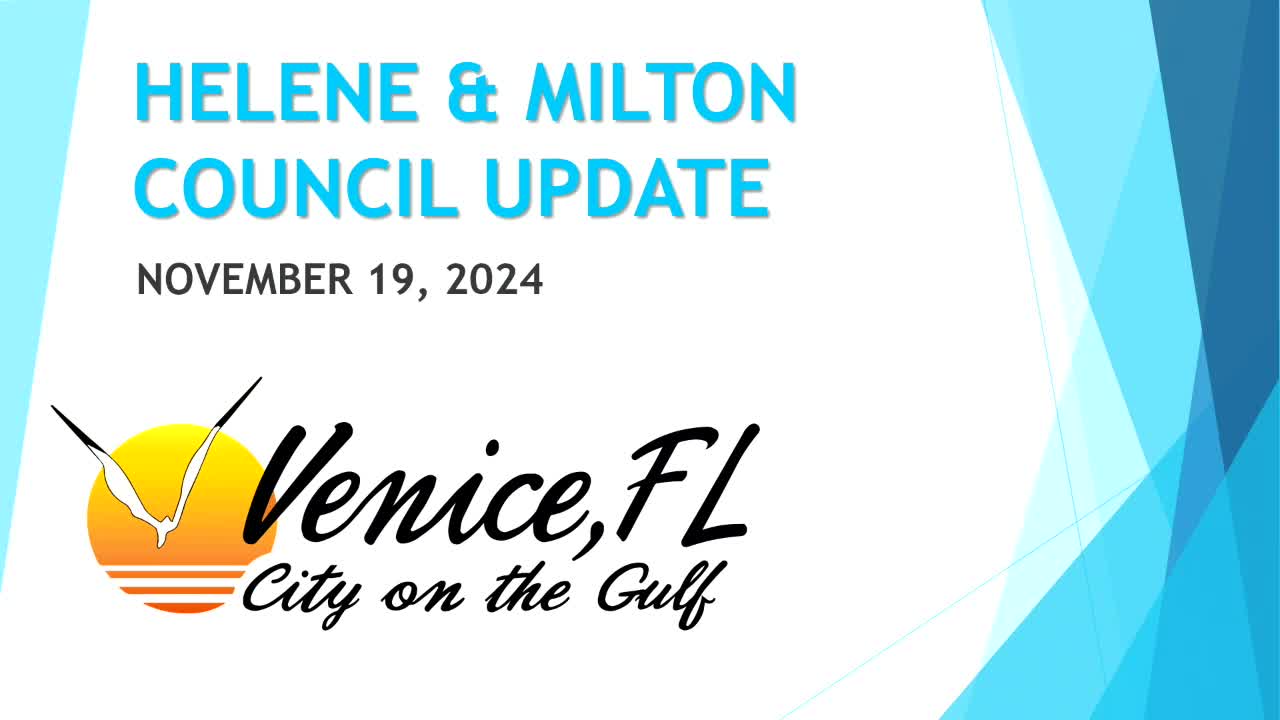Emergency officials detail dramatic impact of back-to-back hurricanes
November 19, 2024 | Venice, Sarasota County, Florida
This article was created by AI summarizing key points discussed. AI makes mistakes, so for full details and context, please refer to the video of the full meeting. Please report any errors so we can fix them. Report an error »

In a recent government meeting, officials provided a comprehensive overview of the impacts of Hurricanes Helene and Milton on the city of Venice, highlighting the community's resilience and the effectiveness of emergency management plans. The presentation, which spanned 68 slides, focused on the significant challenges posed by the back-to-back storms, particularly the storm surge that caused extensive flooding.
Fire Chief Frank Giddens reported that Hurricane Helene made landfall as a Category 4 storm on September 26, resulting in over 230 deaths across affected areas, but fortunately, Venice recorded zero fatalities or injuries. The storm's primary impact was from storm surge, which reached nearly 6 feet, leading to over 50 high water rescues. The city implemented a Level A evacuation, which was crucial in ensuring public safety.
The aftermath of Helene saw the city quickly transitioning to recovery efforts, including damage assessments and debris collection. However, just nine days later, the city faced the threat of Hurricane Milton, which was initially forecasted to be even more severe. The emergency management team had to pivot from recovery to preparation, activating the Emergency Operations Center and issuing evacuation orders for levels A through C—an unprecedented move for the city.
Despite the dire predictions, Milton's impact was less severe than anticipated due to a last-minute weakening of the storm. The actual surge was recorded between 6 to 7 feet, significantly lower than the forecasted 10 to 15 feet. The city experienced minimal rainfall, with less than 2 inches recorded, but still faced widespread power outages and communication disruptions.
Officials emphasized the importance of understanding storm surge dynamics, noting that areas with lower elevations were particularly vulnerable to flooding. The presentation underscored the need for residents to heed evacuation orders and consider property elevation as a key factor in storm preparedness.
As the city continues to recover from these events, officials remain committed to improving response strategies and enhancing community resilience against future storms. The meeting concluded with an invitation for community dialogue, reinforcing the importance of collaboration in disaster preparedness and recovery efforts.
Fire Chief Frank Giddens reported that Hurricane Helene made landfall as a Category 4 storm on September 26, resulting in over 230 deaths across affected areas, but fortunately, Venice recorded zero fatalities or injuries. The storm's primary impact was from storm surge, which reached nearly 6 feet, leading to over 50 high water rescues. The city implemented a Level A evacuation, which was crucial in ensuring public safety.
The aftermath of Helene saw the city quickly transitioning to recovery efforts, including damage assessments and debris collection. However, just nine days later, the city faced the threat of Hurricane Milton, which was initially forecasted to be even more severe. The emergency management team had to pivot from recovery to preparation, activating the Emergency Operations Center and issuing evacuation orders for levels A through C—an unprecedented move for the city.
Despite the dire predictions, Milton's impact was less severe than anticipated due to a last-minute weakening of the storm. The actual surge was recorded between 6 to 7 feet, significantly lower than the forecasted 10 to 15 feet. The city experienced minimal rainfall, with less than 2 inches recorded, but still faced widespread power outages and communication disruptions.
Officials emphasized the importance of understanding storm surge dynamics, noting that areas with lower elevations were particularly vulnerable to flooding. The presentation underscored the need for residents to heed evacuation orders and consider property elevation as a key factor in storm preparedness.
As the city continues to recover from these events, officials remain committed to improving response strategies and enhancing community resilience against future storms. The meeting concluded with an invitation for community dialogue, reinforcing the importance of collaboration in disaster preparedness and recovery efforts.
View full meeting
This article is based on a recent meeting—watch the full video and explore the complete transcript for deeper insights into the discussion.
View full meeting